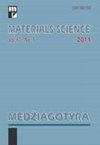Fabrication of Functional Coating Layer for Emerging Transparent Electrodes using Antimony Tin Oxide Nano-colloid
IF 0.6
4区 材料科学
Q4 MATERIALS SCIENCE, MULTIDISCIPLINARY
引用次数: 0
Abstract
This study fabricated a functional coating layer for transparent electrodes using antimony tin oxide nanopowder. The wet grinding method was employed to create a stable dispersion solution of antimony tin oxide nanopowder with aminopropyl tri-methoxysilane and acetyl acetone as primary dispersing agents. Various concentrations of these dispersing agents were used to determine optimal conditions, followed by a gel reaction to form a stable solution. The primary objective was to provide a viable alternative to indium-based transparent electrodes, specifically indium tin oxide, by incorporating antimony oxide. This approach not only addresses limitations associated with indium, but also enhances mechanical properties. The methodology involves the utilization of antimony tin oxide nanopowder and various solvents including ethanol and aforementioned dispersing agents to create a stable antimony tin oxide sol through wet grinding. Effects of dispersant concentration and milling time on the secondary particle size of the antimony tin oxide sol were thoroughly evaluated. Furthermore, this study examined sheet resistance of resulting coating layers by conducting a comparative analysis between antimony tin oxide and indium tin oxide under similar conditions. Findings of this study meticulously detailed in subsequent sections of the manuscript provide valuable insights into optimizing the entire process, encompassing synthesis, coating, heat treatment, and the production of high-quality transparent conductive coatings. These techniques and outcomes can significantly contribute to the development of more sustainable and cost-effective alternatives to traditional indium-based transparent electrodes.新型透明电极用氧化锑锡纳米胶体功能涂层的制备
本研究利用纳米氧化锑锡粉末制备了透明电极的功能涂层。以氨丙基三甲氧基硅烷和乙酰丙酮为一级分散剂,采用湿法研磨法制备了锑氧化锡纳米粉的稳定分散溶液。使用不同浓度的分散剂来确定最佳条件,然后进行凝胶反应以形成稳定的溶液。主要目标是通过加入氧化锑,为铟基透明电极,特别是氧化铟锡电极提供一种可行的替代品。这种方法不仅解决了铟的局限性,而且还提高了机械性能。该方法涉及利用氧化锑锡纳米粉和包括乙醇和上述分散剂在内的各种溶剂,通过湿式研磨制备稳定的氧化锑锡溶胶。研究了分散剂浓度和磨矿时间对氧化锑锡溶胶二次粒径的影响。此外,本研究通过在类似条件下对氧化锑锡和氧化铟锡进行对比分析,检查了所得涂层的片电阻。本研究的结果在手稿的后续章节中详细介绍,为优化整个过程提供了有价值的见解,包括合成,涂层,热处理和高质量透明导电涂层的生产。这些技术和成果可以为开发更具可持续性和成本效益的传统铟基透明电极替代品做出重大贡献。
本文章由计算机程序翻译,如有差异,请以英文原文为准。
求助全文
约1分钟内获得全文
求助全文
来源期刊

Materials Science-medziagotyra
工程技术-材料科学:综合
CiteScore
1.70
自引率
10.00%
发文量
92
审稿时长
6-12 weeks
期刊介绍:
It covers the fields of materials science concerning with the traditional engineering materials as well as advanced materials and technologies aiming at the implementation and industry applications. The variety of materials under consideration, contributes to the cooperation of scientists working in applied physics, chemistry, materials science and different fields of engineering.
 求助内容:
求助内容: 应助结果提醒方式:
应助结果提醒方式:


